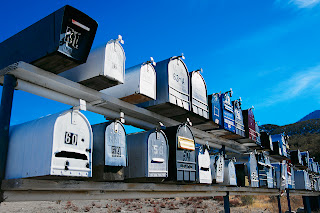Friday, September 28, 2007
Advice for starting your own business
From the well-seasoned to the just-well-intentioned, perfect strangers to best friends, everyone has had advice to share. And the amazing thing is that some of what I’ve heard in the last five months has been just the nudge I needed at the time to help me overcome an obstacle I was facing.
As I reflect on how far I’ve come in such a short amount of time, I want to share some of the best advice I’ve received so far. If you’re facing doubts or are stuck with a problem, I hope these simple-but-effective thoughts help you, too.
Trust your instincts.
If your instinct is that a product won’t sell or a service you could offer would be a hit, trust what your nose tells you. Our instincts exist to propel us forward and help us thrive. Learn to follow them.
Go with your gut.
Where our instincts propel us forward, our gut reactions keep us back when necessary. If a potential deal, partner, investor, location, or supplier doesn’t feel right, trust the gut feeling and avoid it.
Give yourself options.
A few months ago, I had to choose between paying my illustrator for either two or five renditions of new logo designs. Obviously, there was price difference. A fellow entrepreneur ~ and graphic designer ~ advised me to give myself options and ask for the larger package. I’m glad I did. There’s something to be said for casting a wide net.
Just get it done.
Then again, sometimes there can be too many choices. Sometimes, you just have to push forward and get things done. When you’re stuck or overwhelmed, make yourself jump into a task and knock it out of the way. You’ll feel better afterward. And remember: not everything has to be perfect the first time.
Protect your confidence.
It’s easy to look at some of the things you have to do to start a business and think that someone else could do them better than you can. My mentor shared this common experience with me and gave the following advice: “Protect your confidence.” Don’t let anyone or anything erode the confidence you have in yourself and your idea. Sure, others might be better designers, or manufacturers, or whatever…but your business idea belongs to you. Only you can make it happen. Find supportive mentors and friends and soak in their support and encouragement.
Write down your mission and keep it visible.
One day while I was lamenting how easy it is for me to get distracted from my purpose, my boyfriend suggested I copy my mission statement from my business plan and tape it onto my computer monitor. “Keep it eye-level,” he said. “You have to be able to see it at all times.” It’s helped. Whether I’m discouraged, distracted, or bored with what I’m doing, I just glance up at my words of purpose and I instantly feel encouraged. Try it!
Tuesday, September 25, 2007
Save the World and Make Money: Be a Social Entrepreneur
 In the Cascade Business News I was reading on Saturday in Bend, there was an article entitled, “Are Short Term Financial Gains Killing Our Planet?” Subtitled, “How Reforms to Capitalism Can Save the Environment,” the article shared the views of Jonathon Porritt, sustainability advisor to the UK Prime Minister and author of Capitalism: As if the World Matters.
In the Cascade Business News I was reading on Saturday in Bend, there was an article entitled, “Are Short Term Financial Gains Killing Our Planet?” Subtitled, “How Reforms to Capitalism Can Save the Environment,” the article shared the views of Jonathon Porritt, sustainability advisor to the UK Prime Minister and author of Capitalism: As if the World Matters.
Pollitt argues for a more “positive and profound change” in the way the world’s economies work, and suggests several concrete, albeit radical, ways that capitalists can save the planet. Namely:
- Pay real prices for what we take from nature
- Balance short- and long-term economic interests with environmental interests, and
- Promote responsible consumption.
His organization, Forum for the Future, exists to push for just such a change.
If Pollitt’s suggestions are a bit radical, his agenda certainly isn’t. Capitalist concern for the environment and social welfare is more mainstream than ever. On CNN’s web site, would-be capitalists can search “America’s Best Colleges for Entrepreneurs” by the sub-category of Social Entrepreneur programs.
Socially responsible businesses aren’t anything new, but the explosive proliferation of them in the marketplace is. From earth-friendly car care and dry cleaners to wind power plants and biofuels, nearly every one of our daily consumption choices includes some form of socially responsible option.
At least, if you’re in Portland.
And if you’re in Portland, or even in Oregon, you’re also in a great place to join the social entrepreneur movement.
Through the Oregon Entrepreneurs Network, I’ve met some exciting innovators with up-and-coming enviroventures. The ladies behind OsoEco and the guys at End Outdoor are among the next generation of entrepreneurs, intent on showing the world how to develop profitable companies that also do right for our bodies and our Earth.
They, of course, are inspired by forerunners like Nau, New Seasons Market, Hot Lips Pizza, and Patagonia, to name just a few of many pioneering, Oregon-grown socially beneficial businesses.
Whether you start your business from the ground floor with social responsibility in mind, or you have a desire to back into it slowly and gradually, there is no good reason not to do it.
Following are some resources to help you become a social entpreneur.
Read More, Get Smarter
GreenBiz.com, Green Biz Essentials
The New Green Economy Archives at The Lazy Environmentalist Blog
Eco-Entrepreneurs Articles atGreen Options Blog
Network
Opportunity Green Conference: Shaping the Future of Sustainable Business
November 17, 2007, Los Angeles, CA
Eco Packaging
Sunday, September 23, 2007
Feel the Beat: Central Oregon Business Pulse
 A pleasure jaunt with my boyfriend and the mutual friend who introduced us led me to Bend yesterday ~ one of my favorite destinations in Oregon.
A pleasure jaunt with my boyfriend and the mutual friend who introduced us led me to Bend yesterday ~ one of my favorite destinations in Oregon.Monday, September 17, 2007
How to Get Your Own Toll-Free Number
 Like direct mail, a toll-free number is a simple, tried-and-true business essential that gets a bad rap nowadays. In the land of wireless phone networks and voice-over-internet-phone services, some futurists declare a toll-free phone number to be archaic.
Like direct mail, a toll-free number is a simple, tried-and-true business essential that gets a bad rap nowadays. In the land of wireless phone networks and voice-over-internet-phone services, some futurists declare a toll-free phone number to be archaic.Despite the proclamations, however, a toll-free phone number on your business stationery still imparts instant credibility.
Whether you want to increase your sales, look bigger than you are, add substance to your company's claims of superior customer service, or just think your business has the perfect name for a vanity phone number, here are the three main things for you know in order to get your own toll-free number.
1. Select Your Carrier
With telecommunications deregulation, there are now dozens, if not hundreds, of companies you could choose for toll-free service. While AT&T, MCI, and Sprint are the giants, there are numerous small companies competing for your business.
I found Tollfreeforwarding.com through a Google search for toll-free service providers and I was drawn in by their pay-per-click ad that offered a free trial and $10 free credit. While I had some issues at first with the service (see below), I've been happy ever since.
As a small business person, I appreciate vendors who can make my life easier. Tollfreeforwarding.com earned my trust with the free trial, has lower rates than the big guys, and has an online command center that enables me to easily see my bills, track my calls, and set up call forwarding rules whenever I'm away from the office.
2. Select Your Number
Getting any, old toll-free number isn't a problem. Getting one that matches your business phone number or one that spells something particular is a bit of a trick. Not only are you going to find that most 800- prefix numbers are already taken, so are the 877-, 866-, and 888- versions.
The big dog in all things phone, AT&T, has a useful toll-free search tool that lets you plug in one or more digits and find the phone numbers with the digits you want. As a personal note, I admit to spending WAY too much time with that search tool.
3. Test Your Number
Once you pick your number, take it back to the carrier you've chosen (or stay with AT&T if you prefer) and sign up. It will take a few days to activate the new phone number.
Despite your excitement to tell the world about your 800-number, don't rush out and do that. Before you publish your new toll-free number, make sure it works to your satisfaction! Check sound quality, crispness, stability in length of calls, and make sure it works from calls coming from all areas.
My first week with Tollfreeforwarding.com wasn't looking good. My friends, family and vendors in Canada weren't able to use the number and my first two emails to Customer Service didn't elicit any response. My third email connected me with a Customer Service rep who worked for several days to solve the problem. He was professional, personal, and saw the job through to completion. Problem solved, phone number works well, and I'm happy to tell others, namely you, about my experience.
Other Resources
Business Week: "Toll-Free Service Buyer's Guide"
eZine Articles: "Selecting a Toll Free Number?"
PhoneSpell.org: Enter up to 16 digits to see what words can be made from them.
Sunday, September 16, 2007
A "Yoga-as-Business" Metaphor
 When I first started learning yoga, I was stunned at how holding my body still in a pose could appear so effortless from the outside, but feel so intense on the inside.
When I first started learning yoga, I was stunned at how holding my body still in a pose could appear so effortless from the outside, but feel so intense on the inside.As I was going through my series of yoga poses this morning, I thought about how learning to be a business owner is similar.
For years, I used to look at successful people who own their own businesses and think that they made it look so effortless. But just like practicing yoga, it only appears to be effortless from the outside. On the inside, both require strength, discipline, and focus.
Saturday, September 15, 2007
Buying a Business: Questions to Ask in the Process
 Before I decided to start my own business, I had gone thorough two attempts at buying other companies.
Before I decided to start my own business, I had gone thorough two attempts at buying other companies.The first time, I decided not to make an offer after thorough examination of the sales and financial reports with my CPA showed how long I'd have to pump my own capital into the business before I could turn a reasonable profit.
The second time, I was looking at a business that wasn't "market-ready" (the owner was privately in discussion with me to buy, but hadn't listed the company or prepared it for sale). In that case, I consulted with two banks and my CPA to determine the value of the business, made an offer, but was met with an unrealistic counter-offer from the owner that was more than triple the value of the company.
Both experiences were tremendous learning opportunities and I have no regrets about the money or time I spent on them, even though they didn't turn into what I expected or hoped.
If you're considering buying someone else's business, ask the broker or owner the following questions to try to determine if the business is the right fit for you.
(Note: This is by no means a thorough list! The due diligence process of learning about a business can take weeks or even months. These are just some starters to help you get a feel for the circumstances the business faces--and that you would face if you were to take over. I strongly recommend you to work with a skilled accountant and attorney if you're interested in buying a business.)
- What's the corporate structure?
- What are the posted (or regular) business hours? How many days a year is the business open? Has it varied greatly over the years or stayed relatively the same?
- Why specifically do the owners want to sell now? Are there any threats or problems on the horizon? Has there been major displacement by a competitor?
- Has anything changed with any suppliers? Any terms of contracts different now? If so, why?
- What's motivating the sellers? What do they hope to walk away from with the sale?
- Are there any filings against the business of any kind (tax, legal, financial)? (Note: you should pay your accountant and attorney at some point in the process to conduct a search for this information on your own. Don't take the seller's word at face value, no matter how much you trust them.)
- What kind of financing are the sellers offering? On what conditions?
Wednesday, September 12, 2007
Trade Associations Aid Small Businesses
Trade magazines and memberships to writers’ associations have provided leads and resources to me that I wouldn’t have been able to access on my own. From national research on setting copywriting rates, referrals to companies that specialize in answering my profession’s business management needs, and newsletters that connect me to project postings, I can find a wealth of helpful information from the handful of trade sources I’ve joined.
Whether membership is charged monthly or annually, the network will give you back more than you pay for it, especially if you mine it for all it’s worth.
Membership really does have its privileges.
Tuesday, September 11, 2007
The Double-Edged Sword of Perfectionism
 I’m curious how many other small business owners feel both compelled and trapped by perfectionism.
I’m curious how many other small business owners feel both compelled and trapped by perfectionism.On the one hand, my desire to present a polished final product to customers is driving me to pay attention to the smallest details. This is a good thing because the attention will yield a result that makes me proud and that people will respect.
On the other hand, it’s taking so long to learn about those details and to make every minute decision so carefully, that I wonder if I’m making it harder for myself to do what I need to do. It’s a bad thing if I’m not able to move forward on other objectives and higher priorities because I’m “sweating the small stuff.”
For example, I’m spending a surprising amount of time trying to create business cards that represent my commitment to quality—without spending a fortune on four-color offset printing. I’ve been on the phone with my graphic designer and a friend of mine who manages a print shop. I’ve driven out to look at Pantone books and spent close to an hour with both of them trying to explain the difference to me between Pantone colors and CMYK blends for digital printing.
I’ve reviewed one set of proofs, was unsatisfied, and now have to go look at another proof sheet, even though the machine that created the second proof sheet can’t use the heavier stock paper that I want.
Ultimately, I may end up choosing a specialized digital printer from California, and then flying proof sheets up to me in Oregon.
And all of this is will be to create a product that isn’t even up to the high standard that I want—recycled card stock paper printed with environmentally-friendly ink.
My way of coping with my own perfectionism: I allow it to exist and give it space, but I reign myself in, too. I set a time limit for how much I’ll work on the source of vexation and at the end of the time, I move on to more important priorities.
A waste of time? Or a valuable commitment to quality? What do *you* do when your perfectionism crosses the line from being useful to being an impediment?
Saturday, September 8, 2007
Plan Seasonal Promotions Now
 On my daily walk yesterday, I spotted a lovely, but frightening thing ~ chrysanthemums planted in a tree stump in somebody's yard.
On my daily walk yesterday, I spotted a lovely, but frightening thing ~ chrysanthemums planted in a tree stump in somebody's yard.I know the first day of school was Wednesday, and I know the days are getting shorter, but it was the yellow and brown mums that made me feel the chill of autumn.
Many small business owners have high revenue expectations for Q4. (I've mentioned that I have a direct mailing planned myself...)
If you haven’t already begun to plan your strategy for holiday marketing, now is the time. November and December will be here before you can say “Boo.”
Friday, September 7, 2007
Apple "Oops" Offers Lesson for Small Businesses
 When I watched the news Wednesday evening, I was surprised to hear the announcement by Apple that it was cutting the price of an iPhone by $200 (photo courtesy of Apple).
When I watched the news Wednesday evening, I was surprised to hear the announcement by Apple that it was cutting the price of an iPhone by $200 (photo courtesy of Apple).“Wow,” I thought, “there are going to be thousands of very upset iPhone customers.”
People waited in line for days to get their hands on one of the new toys ~ I mean tools ~ and paid $599 (and up) for the privilege. Not only that, but those dedicated Apple disciples hyped the phone and added to its market value by giving it cache.
This is the thanks they get for that loyalty? To see new customers pay 2/3 of what they did?
Apple CEO Steve Jobs said yesterday in an interview published in USA Today that the first iPhone customers would have to understand “that’s technology.” He weakly suggested that they return to the store where they bought the iPhone and try to get some money back from them.
What the?!
While most small businesses will not be in a position to create so much outrage or offend quite so many of its loyal customers in one swift motion, small businesses can still take note of the importance of owning up to mistakes. Jobs’ quick turnaround provides the best “teachable moment” of this story.
Oftentimes, companies—especially small businesses—drag their feet and take too long to correct errors. I’ve seen small businesses take months, even up to a year, to remedy mistakes in shipping the wrong merchandise, or applying a credit for returned merchandise. By the time the error is corrected, the customer’s loyalty has already been lost.
When you make a mistake with your small business customers—and you will, it’s part of life—move swiftly and sincerely to make amends.
Thursday, September 6, 2007
Delegate, Delegate, Delegate
Why not? You can. You’re a multi-talented individual who doesn’t know the meaning of the word “can’t.” You get things done. You move things forward. You’re a builder, innovator, visionary and technician. You aren’t afraid to roll up your sleeves and get your hands dirty.
But just because you *can* do everything, doesn’t mean you *should.*
To be able to grow your business, achieve personal and financial freedom, and lead others to be the best they can be, you have to turn things over to others. Otherwise, as your business grows, so do all of your job responsibilities. Sooner or later, all those balls you juggle will become more than you can handle.
Letting go doesn’t mean abdicating your managerial duties or ignoring how your business is running. It means setting expectations of what should be accomplished and how. It means documenting your expectations in writing and communicating them verbally to staff and contractors. It means monitoring people’s ability to meet those expectations and it means rewarding them and celebrating them when they get there.
Identify the jobs you do best and focus your energies on doing those things yourself. The other stuff – delegate!
Smart delegation is the best way to ensure that your business fuels your life, as opposed to sacrificing your life to fuel your business. As Michael Gerber says in the E-Myth, the excitement of being an entrepreneur is in working *on* your business, not working *in* it.
Have a story about how smart delegation saved your sanity? Share it!
Monday, September 3, 2007
Happy Labor Day

Over and over again, entrepreneurs would describe the long hours they devoted to growing their businesses. “There are no such things as weekends anymore,” they’d say. And to underscore the point, “I don’t feel like I’m ever NOT working.”
Their comments would bear out in my observations. I would watch my boss, the owner of a small company, work 60-hour weeks. She was frequently at the office for 12-hour days and came in nearly every weekend.
For several years, fear of losing my life was the main reason I didn’t pursue owning my own business. I enjoyed being able to leave office troubles behind at the end of my work day and to relax at home. I enjoyed pursuing recreational activities and new relationships outside of work and wanted to continue investing my time in social, rather than professional, pursuits.
But my life and needs changed. I’m now in a place where I’m ready to devote more time to professional interests and where my excitement over pursuing my creative ideas trumps my fear of being consumed by them.
That said, today is a holiday. Most employees are enjoying the day off and I’m at my computer, preparing quotes and editing a client’s web copy. And you know what? I’m happy to be doing it.
I’m working today because I choose to…because on Friday I chose to do other activities instead of working on these items. I love having the freedom to decide when I’m going to work and how I’m going to work.
And on this Labor Day, that’s what I’m celebrating.
Sunday, September 2, 2007
Widget Blog Blog Widget
I use Intuit's Quickbooks software for my business accounting and believe the company's programs and services do make life easier for small business owners. I hope you find the small business profiles a useful and inspirational complement to the information in my blog.
And speaking of my blog...as of this morning, you can add a "Ditch the Dusty Widget" blog widget (aka, "blidget") to your own blog! My blog widget from Widgetbox can be customized to blend with your blog template and is easy to install.
Click here to add my blidget to your site:

Do it now and in less than 1.5 minutes, you can have "Dusty Widget" advice and resources streaming to your viewers 24/7.
Saturday, September 1, 2007
Direct Mail 101








